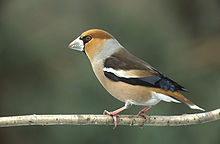Coccothraustes
| Coccothraustes | |
|---|---|

| |
| Hawfinch | |
| Scientific classification | |
| Domain: | Eukaryota |
| Kingdom: | Animalia |
| Phylum: | Chordata |
| Class: | Aves |
| Order: | Passeriformes |
| Family: | Fringillidae |
| Subfamily: | Carduelinae |
| Genus: | Coccothraustes Brisson, 1760 |
Coccothraustes is a genus of the finch family (Fringillidae).
The genus was introduced by the French zoologist Mathurin Jacques Brisson in 1760 based on tautonymy and the binomial name Loxia coccothraustes of Carl Linnaeus.[1][2]
The genus contains three species:[3]
| Image | Scientific name | Common Name | Distribution |
|---|---|---|---|
 |
Coccothraustes coccothraustes | Hawfinch | Europe and temperate Asia |
 |
Coccothraustes vespertinus | Evening grosbeak | Canada and the western mountainous areas of the United States and Mexico |
 |
Coccothraustes abeillei | Hooded grosbeak | Central America, principally in Mexico and Guatemala. |
The hawfinch (Coccothraustes coccothraustes) has long been recognised as being closely related to other grosbeaks in the genera Mycerobas, Hesperiphona and Eophona. This was confirmed by molecular genetic studies that showed that the four genera form a well-defined clade.[4] Some authorities have grouped all the species into a single large genus Coccothraustes but this is usually split.[1] Clements and colleagues include the evening grosbeak and the hooded grosbeak in Coccothraustes[5] but the International Ornithologists' Union retain only the hawfinch in the genus.[3]
Molecular genetic studies have shown the finches with large beaks in the Chaunoproctus, Rhynchostruthus and Neospiza genera are not closely related. The similar bill morphology is the result of convergent evolution due to the similar feeding behaviour.[4]
References
- ^ a b Paynter, Raymond A. Jnr., ed. (1968). Check-list of Birds of the World. Vol. Volume 14. Cambridge, Massachusetts: Museum of Comparative Zoology. pp. 299–305.
{{cite book}}:|volume=has extra text (help) - ^ Brisson, Mathurin Jacques (1760). Ornithologie (in French). Paris: Chez C.J.-B. Bauche. Vol. 1 p. 36, Vol. 3 p. 218.
- ^ a b Gill, Frank; Donsker, David (eds.). "Finches, euphonias". World Bird List Version 5.2. International Ornithologists' Union. Retrieved 5 June 2015.
- ^ a b Zuccon, Dario; Prŷs-Jones, Robert; Rasmussen, Pamela C.; Ericson, Per G.P. (2012). "The phylogenetic relationships and generic limits of finches (Fringillidae)" (PDF). Molecular Phylogenetics and Evolution. 62 (2): 581–596. doi:10.1016/j.ympev.2011.10.002. PMID 22023825.
- ^ Clements, J.F.; Schulenberg, T.S.; Iliff, M.J.; Roberson, D.; Fredericks, T.A.; Sullivan, B.L.; Wood, C.L. (2014). "eBird/Clements checklist of birds of the world: Version 6.9". The Cornell Lab of Ornithology. Retrieved 23 June 2015.
